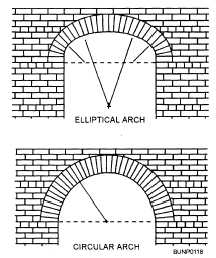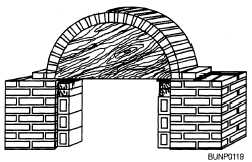
Figure 4-l8. - Joint finishes.

Figure 4-19. - Common arch shapes.
supports must not only be able to support the masonry during construction but also provide the geometry necessary for the proper construction and appearance of the arch. Such supports are called templets.

Figure 4-20. - Using a template to construct an arch.
DIMENSIONS. - Construct a brick arch over the templet (fig. 4-20) that remains in place until the mortar sets. You can obtain the templet dimensions from the construction drawings. For arches spanning up to 6 feet, use 3/4-inch plywood to make the templet. Cut two pieces to the proper curvature, and nail them to 2 by 4 spacers that provide a surface wide enough to support the brick.
POSITIONING. - Use wedges to hold the templet in position until the mortar hardens enough to make the arch self-supporting. Then drive out the wedges.
Layout
Lay out the arch carefully so that you don't have to cut any bricks. Use an odd number of bricks so that the key, or middle, brick falls into place at the exact arch center, or crown. The key, or middle, brick is the last one laid. To determine how many bricks an arch requires, lay the templet on its side on level ground and set a trial number of bricks around the curve. Adjust the number of bricks and the joint spacing (not less than one-fourth inch) until the key brick is at the exact center of the curve. Then mark the positions of the bricks on the templet and use them as a guide when laying the brick.
ESTIMATING BRICK AND MORTAR
When estimating the number of brick and the quantity of mortar, you need to know the exact size of the brick and the thickness of the mortar joint. This information is found in the plans or specifications. Table 4-5 shows the quantities of material required for brick walls.
NOTE: Quantities of brick include the thickness of the mortar joint and no allowance for waste.Continue Reading
